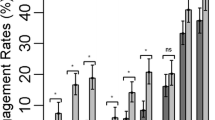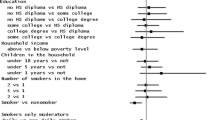Abstract
Improving smoking intervention trial retention in underserved populations remains a public health priority. Low retention rates undermine clinical advancements that could reduce health disparities. To examine the effects of recruitment strategies on participant retention among 279 low-income, maternal smokers who initiated treatment in a 16-week behavioral counseling trial to reduce child secondhand smoke exposure (SHSe). Participants were recruited using either reactive strategies or methods that included proactive strategies. Logistic regression analysis was used to test associations among retention and recruitment method in the context of other psychosocial and sociodemographic factors known to relate to retention. Backwards stepwise procedures determined the most parsimonious solution. Ninety-four percent of participants recruited with proactive + reactive methods were retained through end of treatment compared to 74.7% of reactive-recruited participants. Retention likelihood was five times greater if participants were recruited with proactive + reactive strategies rather than reactive recruitment alone (odds ration [OR] = 5.36; confidence interval [CI], 2.31–12.45). Greater knowledge of SHS consequences (OR = 1.58; CI, 1.07–2.34) was another significant factor retained in the final LR model. Proactive recruitment may improve retention among underserved smokers in behavioral intervention trials. Identifying factors influencing retention may improve the success of recruitment strategies in future trials, in turn, enhancing the impact of smoking interventions.
Similar content being viewed by others
References
Leon, A. C., Demirtas, H., & Hedeker, D. (2007). Bias reduction with an adjustment for participants’ intent to dropout of a randomized controlled clinical trial. Clinical Trials, 4(5), 540–547.
Biglan, A., Hood, D., Brozovsky, P., Ochs, L., Ary, D., & Black, C. (1991). Subject attrition in prevention research. NIDA Research Monographs, 107, 213–234.
Siddiqi, A. E., Sikorskii, A., Given, C. W., & Given, B. (2008). Early participant attrition from clinical trials: role of trial design and logistics. Clinical Trials, 5(4), 328–335.
Curtin, L., Brown, R. A., & Sales, S. D. (2000). Determinants of attrition from cessation treatment in smokers with a history of major depressive disorder. Psychology of Addictive Behaviors, 14(2), 134–142.
Hall, S. M., Munoz, R. F., & Reus, V. I. (1994). Cognitive–behavioral intervention increases abstinence rates for depressive-history smokers. Journal of Consulting and Clinical Psychology, 62(1), 141–146.
Klesges, R. C., Brown, K., Pascale, R. W., Murphy, M., Williams, E., & Cigrang, J. A. (1988). Factors associated with participation, attrition, and outcome in a smoking cessation program at the workplace. Health Psychology, 7(6), 575–589.
Blumenthal, D. S., Sung, J., Coates, R., Williams, J., & Liff, J. (1995). Recruitment and retention of subjects for a longitudinal cancer prevention study in an inner-city black community. Health Services Research, 30(1 Pt 2), 197–205.
Fox, D. P., & Gottfredson, D. C. (2003). Differentiating completers from non-completers of a family-based prevention program. Journal of Primary Prevention, 24(2), 111–124.
Giuliano, A. R., Mokuau, N., Hughes, C., et al. (2000). Participation of minorities in cancer research: the influence of structural, cultural, and linguistic factors. Annals of Epidemiology, 10(8 Suppl), S22–S34.
Gross, D., Julion, W., & Fogg, L. (2001). What motivates participation and dropout among low-income urban families of color in a prevention intervention? Family Relations, 50(3), 246–254.
Ramos-Gomez, F., Chung, L. H., Gonzalez Beristain, R., et al. (2008). Recruiting and retaining pregnant women from a community health center at the US–Mexico border for the Mothers and Youth Access clinical trial. Clinical Trials, 5(4), 336–346.
Collins, B. N., Wileyto, E., Patterson, F., et al. (2004). Gender differences in smoking cessation in a placebo-controlled trial of bupropion with behavioral counseling. Nicotine and Tobacco Research.
Scharf, D., & Shiffman, S. (2004). Are there gender differences in smoking cessation, with and without bupropion? Pooled- and meta-analyses of clinical trials of Bupropion SR. Addiction, 99(11), 1462–1469.
Pederson, L. L., Ahluwalia, J. S., Harris, K. J., & McGrady, G. A. (2000). Smoking cessation among African Americans: what we know and do not know about interventions and self-quitting. Preventive Medicine, 31(1), 23–38.
Copeland, A. L., Martin, P. D., Geiselman, P. J., Rash, C. J., & Kendzor, D. E. (2006). Predictors of pretreatment attrition from smoking cessation among pre- and postmenopausal, weight-concerned women. Eating Behaviors, 7(3), 243–251.
McIntosh, S., Ossip-Klein, D. J., Spada, J., & Burton, K. (2000). Recruitment strategies and success in a multi-county smoking cessation study. Nicotine & Tobacco Research, 2(3), 281–284.
Harris, K. J., Ahluwalia, J. S., Catley, D., Okuyemi, K. S., Mayo, M. S., & Resnicow, K. (2003). Successful recruitment of minorities into clinical trials: The Kick It at Swope project. Nicotine & Tobacco Research, 5(4), 575–584.
Jeffries, S. K., Choi, W., Butler, J., Harris, K. J., & Ahluwalia, J. S. (2005). Strategies for recruiting African-American residents of public housing developments into a randomized controlled trial. Ethnicity & Disease, 15(4), 773–778.
Staffileno, B. A., & Coke, L. A. (2006). Recruiting and retaining young, sedentary, hypertension-prone African American women in a physical activity intervention study. Journal of Cardiovascular Nursing, 21(3), 208–216.
Webb, M. S., Seigers, D., & Wood, E. A. (2009). Recruiting African American smokers into intervention research: relationships between recruitment strategies and participant characteristics. Research in Nursing and Health, 32(1), 86–95.
Lai, G. Y., Gary, T. L., Tilburt, J., et al. (2006). Effectiveness of strategies to recruit underrepresented populations into cancer clinical trials. Clinical Trials, 3(2), 133–141.
Firestone, P., & Witt, J. E. (1982). Characteristics of families completing and prematurely discontinuing a behavioral parent-training program. Journal of Pediatric Psychology, 7(2), 209–222.
Nevid, J. S., Javier, R. A., & Moulton, J. L., 3rd. (1996). Factors predicting participant attrition in a community-based, culturally specific smoking-cessation program for Hispanic smokers. Health Psychology, 15(3), 226–229.
Agosti, V., Nunes, E., & Ocepeck-Welikson, K. (1996). Patient factors related to early attrition from an outpatient cocaine research clinic. The American Journal of Drug and Alcohol Abuse, 22(1), 29–39.
Ahluwalia, J. S., Richter, K., Mayo, M. S., et al. (2002). African American smokers interested and eligible for a smoking cessation clinical trial: predictors of not returning for randomization. Annals of Epidemiology, 12(3), 2062–12.
Daro, D., McCurdy, K., Falconnier, L., & Stojanovic, D. (2003). Sustaining new parents in home visitation services: key participant and program factors. Child Abuse & Neglect, 27(10), 1101–1125.
King, A. C., & Canada, S. A. (2004). Client-related predictors of early treatment drop-out in a substance abuse clinic exclusively employing individual therapy. Journal of Substance Abuse Treatment, 26(3), 189–195.
Magruder, K. M., Bichun, O., Miller, S., & Tilley, B. C. (2009). Retention of under-represented minorities in drug abuse treatment studies. Clinical Trials, 6(3), 252–260.
Dobkin, P. L., De, C. M., Paraherakis, A., & Gill, K. (2002). The role of functional social support in treatment retention and outcomes among outpatient adult substance abusers. Addiction, 97(3), 347–356.
Levine, M. D., Marcus, M. D., & Perkins, K. A. (2003). A history of depression and smoking cessation outcomes among women concerned about post-cessation weight gain. Nicotine & Tobacco Research, 5(1), 69–76.
Perrino, T., Coatsworth, J. D., Briones, E., Pantin, H., & Szapocznik, J. (2001). Initial engagement in parent-centered preventive interventions: a family systems perspective. Journal of Primary Prevention, 22(1), 21–44.
Collins, B. N., Nair, U., Hovell, M. F., & Audrain-McGovern, J. (2009). Smoking-related weight concerns among underserved, black maternal smokers. American Journal of Health Behavior, 33(6), 699–709.
Lerman, C., Niaura, R., Collins, B. N., et al. (2004). Effect of bupropion on depression symptoms in a smoking cessation clinical trial. Psychology of Addictive Behavior, 18(4), 362–366.
Perkins, K. A. (2001). Smoking cessation in women. Special considerations. CNS Drugs, 15(5), 391–411.
Conway, T. L., Woodruff, S. I., Edwards, C. C., Hovell, M. F., & Klein, J. (2004). Intervention to reduce environmental tobacco smoke exposure in Latino children: null effects on hair biomarkers and parent reports. Tobacco Control, 13(1), 90–92.
Emmons, K. M., Hammond, S. K., Fava, J. L., Velicer, W. F., Evans, J. L., & Monroe, A. D. (2001). A randomized trial to reduce passive smoke exposure in low-income households with young children. Pediatrics, 108(1), 18–24.
Gonzales, M., Malcoe, L. H., Kegler, M. C., & Espinoza, J. (2006). Prevalence and predictors of home and automobile smoking bans and child environmental tobacco smoke exposure: A cross-sectional study of U.S.- and Mexico-born Hispanic women with young children. BMC Public Health, 6, 265.
Hovell, M. F., Wahlgren, D. R., & Gehrman, C. A. (2002). The behavioral ecological model: Integrating public health and behavioral science. San Francisco: Jossey-Bass.
Hovell, M. F., Wahlgren, D. R., Adams, M. A. (2009). The logical and empirical basis for the behavioral ecological model. Emerging theories and models in health promotion research and practice. 2nd edn.
Hovell, M., & Hughes, S. (in press). The behavioral ecology of secondhand smoke exposure: A pathway to complete tobacco control. Nicotine and Tobacco Research.
Heatherington, T. F., Kozlowski, L. T., Frecker, R. C., & Fagerstrom, K. O. (1991). The Fagerstrom Test for nicotine dependence: a revision of the Fagerstrom tolerance questionnaire. British Journal of Addiction, 86, 1119–1127.
Radloff, L. (1977). A CES-D scale: a self-report depression scale for research in the general population. Applied Psychology Measurement, 1, 385–401.
Brookings, J. B., & Bolton, B. (1988). Confirmatory factor analysis of the Interpersonal Support Evaluation List. American Journal of Community Psychology, 16(1), 137–147.
Matt, G. E., Hovell, M. F., Zakarian, J. M., Bernert, J. T., Pirkle, J. L., & Hammond, S. K. (2000). Measuring secondhand smoke exposure in babies: the reliability and validity of mother reports in a sample of low-income families. Health Psychology, 19(3), 232–241.
Matt, G. E., Wahlgren, D. R., Hovell, M. F., et al. (1999). Measuring environmental tobacco smoke exposure in infants and young children through urine cotinine and memory-based parental reports: empirical findings and discussion. Tobacco Control, 8(3), 282–289.
Hovell, M., & Daniel, J. (2005). Defining residential tobacco home policies: a behavioural and cultural perspective. Archives of Disease in Childhood, 90(7), 661–662.
Hovell, M. F., Slymen, D. J., Keating, K. J., et al. (1996). Tobacco use prevalence and correlates among adolescents in a clinician initiated tobacco prevention trial in California, USA. Journal of Epidemiology and Community Health, 50(3), 340–346.
Acknowledgements
This work was supported by the National Cancer Institute at the National Institutes of Health to BC [K07 CA093756 and R01 CA105183]; the Maternal and Child Health Bureau at the Department of Health Services to MH [R40 MC 00185 and R40 MC 02494]; and the National Heart, Lung and Blood Institute at National Institutes of Health to MH [R01 HL066307]. The authors would like to thank the Health Behavior Research Clinic staff and students at Temple University for their dedicated efforts to this project.
Author information
Authors and Affiliations
Corresponding author
Additional information
Implications
Practice: Smoking intervention providers could consider partnering with community agencies to design and implement proactive referral strategies given that these strategies may facilitate enrollment as well as retention of clients through end of treatment.
Policy: Providing resources for strategic intervention recruitment and retention efforts that target underserved smokers would improve the public health impact of smoking interventions in populations with the greatest tobacco-related morbidity and mortality risk.
Research: To facilitate retention of low-income, underserved participants in community-based smoking intervention trials, the results suggest the need to develop and implement clinic-tailored, proactive recruitment strategies.
About this article
Cite this article
Collins, B.N., Wileyto, E.P., Hovell, M.F. et al. Proactive recruitment predicts participant retention to end of treatment in a secondhand smoke reduction trial with low-income maternal smokers. Behav. Med. Pract. Policy Res. 1, 394–399 (2011). https://doi.org/10.1007/s13142-011-0059-6
Published:
Issue Date:
DOI: https://doi.org/10.1007/s13142-011-0059-6




